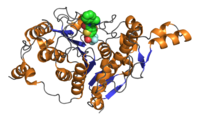
Photo from wikipedia
The basic units of chromatin are nucleosomes, that are made up of DNA wrapped around histone cores. Histone lysine residue is a common location for posttranslational modifications, with acetylation being… Click to show full abstract
The basic units of chromatin are nucleosomes, that are made up of DNA wrapped around histone cores. Histone lysine residue is a common location for posttranslational modifications, with acetylation being the second most prevalent. Histone acetyltransferases (HATs/KATs) and histone deacetylases (HDACs/KDACs) regulate histone acetylation, which is important in gene expression control. HDACs/KDACs regulate gene expressions through the repression of the transcription machinery. HDAC/KDAC isoforms play a major role during various stages of embryo development and neurogenesis. In specific, class I and II HDACs/KDACs are involved in cardiac muscle differentiation and development. An insight into different pathways and genes associated with embryonic development, the effect of HDAC/KDAC activity during the embryonic stem cell differentiation, preimplantation, embryo development, gastrulation, and the role of different HDAC/KDAC inhibitors during the process of embryogenesis is summarized in the present review article.
Journal Title: Molecular Reproduction and Development
Year Published: 2022
Link to full text (if available)
Share on Social Media: Sign Up to like & get
recommendations!